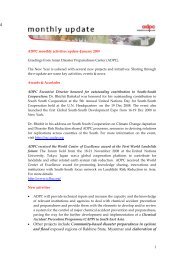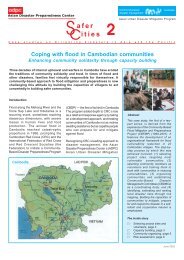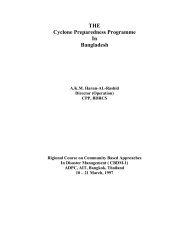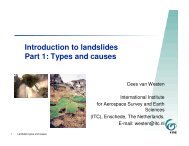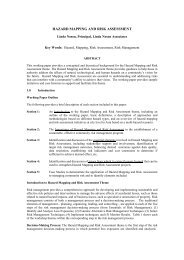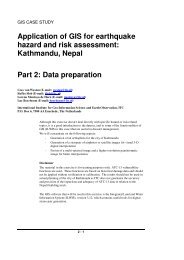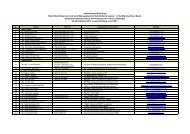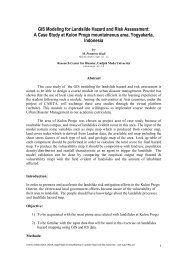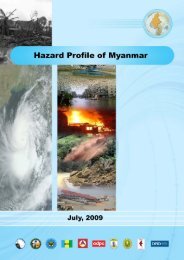community-based disaster risk management and the media media kit
community-based disaster risk management and the media media kit
community-based disaster risk management and the media media kit
Create successful ePaper yourself
Turn your PDF publications into a flip-book with our unique Google optimized e-Paper software.
130<br />
MEDIA KIT<br />
for Disaster Management (PCDM) implemented Disaster<br />
Preparedness projects funded by DipECHO <strong>and</strong> MRC. In<br />
<strong>the</strong> course of <strong>the</strong> years, ACF focused its Disaster<br />
Preparedness projects on three main components:<br />
1. Streng<strong>the</strong>ning PCDM, DCDM (District Committee<br />
for Disaster Management) <strong>and</strong> CCDM (Commune<br />
Committee for Disaster Management)<br />
2. Flood Early Warning System for vulnerable<br />
communities<br />
3. Flood Information <strong>management</strong><br />
Early Warning System for Vulnerable Communities Along<br />
<strong>the</strong> Mekong River <strong>and</strong> Flood Information Management<br />
The Early Warning System (EWS) is a very promising<br />
activity in terms of relevance <strong>and</strong> sustainability. Using<br />
<strong>the</strong> daily forecast of <strong>the</strong> Mekong River Commission,<br />
received by e-mail at <strong>the</strong> PRC offi ce around 12:00 p.m.,<br />
<strong>the</strong> PRC radio operator sends at 2:00 p.m. by VHF radio<br />
<strong>the</strong> forecast to each village volunteer (47 villages now <strong>and</strong><br />
25 more in 2005). The village volunteer (Village chief or<br />
Red-Cross Volunteer) displays <strong>the</strong> current <strong>and</strong> 3-days<br />
forecast water level on a specially designed public board.<br />
Blue <strong>and</strong> green arrows show <strong>the</strong> trend of <strong>the</strong> water level<br />
in <strong>the</strong> village (increase or decrease) for <strong>the</strong> present day<br />
<strong>and</strong> <strong>the</strong> 3 next days. Finally, a warning sign (green, orange<br />
or red) inform <strong>the</strong> villagers if <strong>the</strong> village is nearly to be<br />
fl ooded or will be fl ooded in <strong>the</strong> coming days. The warning<br />
level is specifi c to each village <strong>and</strong> defi ned by <strong>the</strong> villagers<br />
through participatory meeting.<br />
The implementation of EWS activity in a village starts with<br />
a participatory meeting where, after a hazard-capacityvulnerability<br />
assessment, villagers expressed <strong>the</strong>ir<br />
knowledge on prediction <strong>and</strong> forecast <strong>and</strong> <strong>the</strong>ir preferred<br />
way to receive <strong>the</strong> forecast. The warning levels specifi c to<br />
each village are defi ned, as well as <strong>the</strong> way <strong>and</strong> persons



